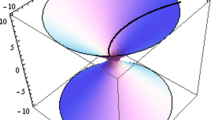Abstract
In this paper, we study some global properties of curves in the Heisenberg group \(H_{1}\). In particular, we obtain Fenchel-type theorem and Fáry–Milnor type theorem, together with Bray–Jauregui type theorem. We also prove the fundamental theorem of curves in the standard CR 3-sphere \(S^{3}\). As an application, we classify some horizontally regular curves in \(S^{3}\).
Similar content being viewed by others
References
Bray, H.L., Jauregui, J.L.: On curves with nonnegative torsion. Arch. Math. (Basel) 104, 561–575 (2015)
Chern, S.S., Cheng, W.H., Lam, K.S.: Lecture Notes on Differential Geometry (Chinese Version). World Publishing Company, New York (1999)
Chiu, H.L.: The sharp lower bound for the first positive eigenvalue of the sublaplacian on a pseudohermitian \(3\)-manifold. Ann. Glob. Anal Geom. 30, 81–96 (2006)
Chiu, H.L., Feng, X., Huang, Y.C.: The differential geometry of curves in the Heisenberg groups. Differ. Geom. Appl. 56, 161–172 (2018)
Chiu, H.L., Huang, Y.-C., Lai, S.H.: An application of the moving frame method to integral geometry in the Heisenberg group. SIGMA symmetry integrability. Geom. Methods Appl. 13(097), 27 (2017)
Chiu, H.L., Lai, S.H.: The fundamental theorem for hypersurfaces in Heisenberg groups. Calc. Var. Part. Differ. Equ. 54, 1091–1118 (2015)
do Carmo, M.P.: Differential Geometry of Curves and Surface. Prentice Hall, Englewood Cliffs, NJ (1976)
Fáry, I.: Sur la courbure totale d’une courbe gauche faisant un næud. Bull. Soc. Math. France 77, 128–138 (1949)
Fenchel, W.: Über Krümmung und Windung geschlossener Raumkurven. Math. Ann. 101, 238–252 (1929)
Godoy Molina, M., Markina, I.: Sub-Riemannian geodesics and heat operator on odd dimensional spheres. Anal. Math. Phys. 2, 123–147 (2012)
Milnor, J.W.: On the total curvature of knots. Ann. Math. 2(52), 248–257 (1950)
Acknowledgements
The authors would like to thank the referee for helpful comments and suggestions. H.-L. Chiu would like to thank the Ministry of Science and Technology of Taiwan for the Grant # 106-2115-M-007-017-MY3, and P. T. Ho was supported by the National Research Foundation of Korea (NRF) Grant funded by the Korea Government (MEST) No. 201731033.01.
Author information
Authors and Affiliations
Corresponding author
Appendix
Appendix
In this appendix, we prove that the number of extremal points of a continuous function on the unit circle must be even. It is probably well known. But we include it here for the sake of completeness.
First we have the following notations. We say that p is a relative maximum (relative minimum, respectively) of f if there exists a neighborhood U of p such that
We say that p is an extremal point of f if p is a relative maximum of f or a relative minimum of f.
Lemma 9.1
Suppose \(f:C\rightarrow \mathbb {R}\) is a real-valued continuous function defined on the unit circle C. If the number of extremal points of f are finite, then the number of extremal points of f must be even.
Proof
It suffices to prove the corresponding statement for the continuous function \(f:[0,2\pi ]\rightarrow \mathbb {R}\) with \(f(0)=f(2\pi )\). We have the following: \(\square \)
Claim 1
Each relative maximum p of f must be strict maximum, i.e., there exists a neighborhood U of p such that
Suppose this is not true. Then we can find a sequence of distinct points \(\{x_i\}_{i=1}^\infty \) such that \(x_i\ne p\) and \(x_i\rightarrow p\) as \(i\rightarrow \infty \) with
This implies that \(x_i\) are all relative maximum of f, which contradicts to the assumption that the number of extremal points of f are finite. This proves the claim.
Similarly, we have the following:
Claim 2
Each relative minimum p of f must be strict maximum, i.e., there exists a neighborhood U of p such that
Now we are ready to prove Lemma 9.1. Since the number of extremal points of f are finite, we can assume that \(\{a_1<\cdots <a_m\}\) and \(\{b_1<\cdots <b_M\}\) are, respectively, the relative minimum of f and relative maximum of f. Since f is a continuous function defined on the compact set \([0,2\pi ]\), f must have a relative maximum and a relative minimum, i.e., \(m, M\ge 1\). On the other hand, in view of Claims 1 and 2, \(a_i\ne b_j\) for all i, j. Then we have the following:
Claim 3
\(m=M\).
Claim 3 implies Lemma 9.1, since the number of extremal points is equal to \(M=m\). To prove claim 3, suppose on the contrary, \(m\ne M\). Without loss of generality, we can assume that \(m<M\). Then there exists \(i=1,\ldots ,M\) such that the interval \([b_i,b_{i+1}]\) does not contain any \(a_j\), i.e., f does not have any relative minimum in the interval \([b_i,b_{i+1}]\). (If \(i=M\), then we identify \(b_{M+1}\) as \(b_1\).) Since f is continuous on the compact interval \([b_i,b_{i+1}]\), there exists an absolute minimum \(x_0\in [b_i,b_{i+1}]\), i.e.,
In view of Claim 1, \(x_0\ne b_i, b_{i+1}\). As a result, \(x_0\) is a relative minimum of f, which is a contradiction. This proves Claim 3. \(\square \)
Rights and permissions
About this article
Cite this article
Chiu, HL., Ho, P.T. Global Differential Geometry of Curves in Three-Dimensional Heisenberg Group and CR Sphere. J Geom Anal 29, 3438–3469 (2019). https://doi.org/10.1007/s12220-018-00122-x
Received:
Published:
Issue Date:
DOI: https://doi.org/10.1007/s12220-018-00122-x




